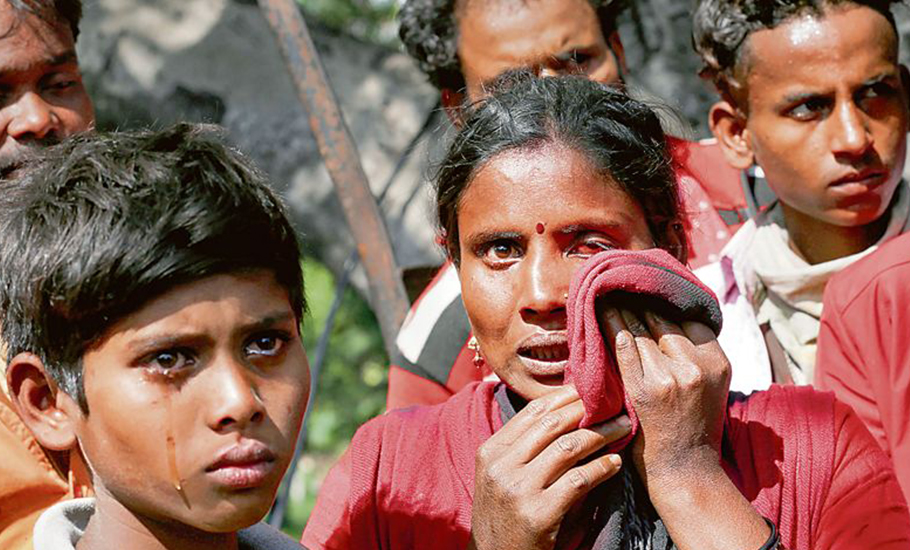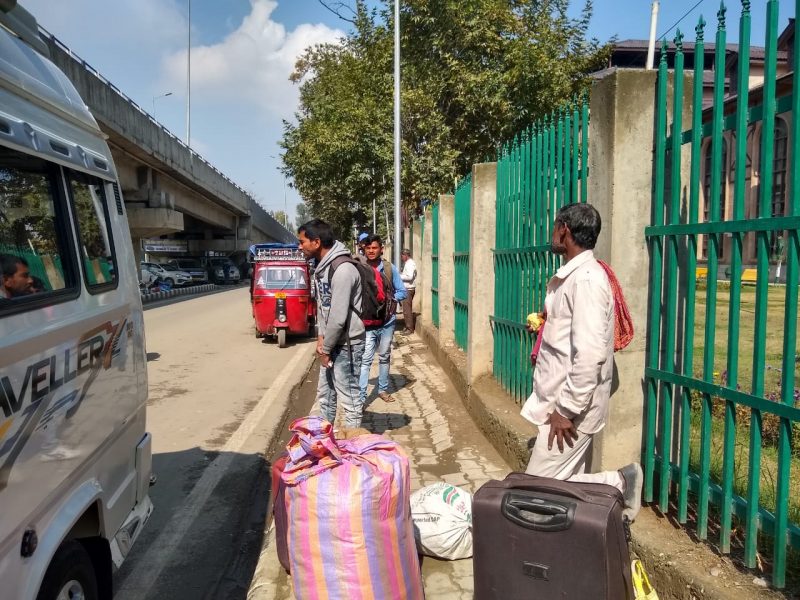
- Home
- News
- Analysis
- States
- Perspective
- Videos
- Education
- Entertainment
- Elections
- World Cup 2023
- Features
- Health
- Budget 2024-25
- Business
- Series
- NEET TANGLE
- Economy Series
- Earth Day
- Kashmir’s Frozen Turbulence
- India@75
- The legend of Ramjanmabhoomi
- Liberalisation@30
- How to tame a dragon
- Celebrating biodiversity
- Farm Matters
- 50 days of solitude
- Bringing Migrants Home
- Budget 2020
- Jharkhand Votes
- The Federal Investigates
- The Federal Impact
- Vanishing Sand
- Gandhi @ 150
- Andhra Today
- Field report
- Operation Gulmarg
- Pandemic @1 Mn in India
- The Federal Year-End
- The Zero Year
- Premium
- Science
- Brand studio
- Home
- NewsNews
- Analysis
- StatesStates
- PerspectivePerspective
- VideosVideos
- Entertainment
- ElectionsElections
- Sports
- Loading...
Sports - Features
- Budget 2024-25
- BusinessBusiness
- Premium
- Loading...
Premium

Targeted killings put migrant workers on a fear flight from Kashmir

On her smartphone, Mehnaz (name changed) is watching on a loop videos of migrant workers leaving Kashmir, the fear and anxiety writ large on her face as yet another turbulent phase unfolds in the Valley. The targeted killing of 12 civilians, including five non-local labourers and members of minority communities, in the last fortnight has triggered fear and fret among seasonal migrants who...
On her smartphone, Mehnaz (name changed) is watching on a loop videos of migrant workers leaving Kashmir, the fear and anxiety writ large on her face as yet another turbulent phase unfolds in the Valley.
The targeted killing of 12 civilians, including five non-local labourers and members of minority communities, in the last fortnight has triggered fear and fret among seasonal migrants who arrive in Kashmir in search of work. Following the attacks, dozens of workers have already left the Valley.
However, Mehnaz’s two-decade-long living experience in the Valley is making her believe that her tribe will eventually overcome this phase as well, with local support. “This is not new, but yes it’s unnerving and alarming,” she said.
For now as a precautionary measure, Mehnaz, who lives in Batpora area, on the outskirts of Srinagar, has taken some days off from her workplace, a biscuit factory in Zakura Industrial area.
She first came to Kashmir in 1995 as a teen bride from Bihar. “For me Kashmir is both my maternal and paternal home,” says Mehnaz. Even when unrest in the Valley was at its peak, Mehnaz adds, she never felt like going back. “People here are warm and hospitable, no matter how hard the situation is for them.”
According to different estimates, including official data, every year nearly three-and-a-half lakh seasonal migrants arrive in J&K for work. Some of them spend the winter months back home and come to the Valley as the spring breeze starts blowing. Others like Mehnaz live throughout the year.
The attacks that shook Kashmir over the last fortnight have given sleepless nights to both the security forces as well as the non-local workforce. The scare is now palpable at bus terminals and railway stations where migrant workers are arriving in droves to leave the Valley.
“What will we do here,” asks Suraj Kumar, a carpenter from Uttar Pradesh. “We fear for our lives. Although locals are supporting us, the police directed us not to leave our rental rooms. How can we survive if we remain holed up in our rooms? We are here to work and if the situation isn’t right for work, we better go home.”
This anguish was also voiced by Sanjay from Bihar’s Bettiah district. On October 17, when two non-local labourers were killed in Kulgam and a third one was injured, police arrived at the rented accommodation of Sanjay and 20 other migrant workers. “We thought it’s better to go with them to some secure place,” Sanjay says.
“I am fine so far, but my family back home is insisting I leave as early as possible. The reports on news channels have panicked them,” he adds. On October 18, around 7 pm, police told Sanjay and others that an order had come from the high-ups to release them from the secured accommodation. “They advised us to remain alert and return from work before dusk,” he tells The Federal.
After the killing of migrant laborers in Kulgam, an internal communication by the J&K Police attributed to Inspector General of police in Kashmir, Vijay Kumar, went viral on social media platforms, directing police officials to immediately shift non-locals to nearby police stations, paramilitary or army camps.
Even as Kumar termed the leaked communication as “fake”, the visuals on social media showed non-locals being shifted to secured accommodations. Sanjay was one of them.
The administration has made arrangements for the safe stay of non-locals at over 10 places across the Valley in view of the security situation in the area. With the rush at camps rising, divisional commissioner PK Pole says, “Labourers coming from other states are being given all necessary assistance. The employers who have invited these labourers have also been asked to look after their needs.
The Federation Chamber of Industries Kashmir (FCIK) has expressed concern over the situation and requested them to ensure safety of the migrants. In a statement FCIK said, “We have non-local workforce in good numbers in units across Kashmir. They have been part of our industrial growth story. The government should provide them enhanced security cover so that they can work without any fear and their families feel secure.” FCIK president Shahid Kamili said that all office-bearers of industrial associations of Kashmir are in touch with the migrant workforce and boosting their morale to continue working in their industrial units.
According to officials, station house officers of all police stations have been directed to list the details of all migrant workers or visitors present in their jurisdiction. The police are also patrolling the roads consistently and frisking is going on on a mass scale to avoid any further targeted attacks, especially against the non-locals.
As winter sets in, it is normal for labourers from outside to return to their native states around November-December since economic activities take a dip.
Those who have advanced the date of their journey this year because of the targeted killings are being aided by the authorities.
“We have decided to go to Jammu. We will harvest paddy there and earn some money, before heading home. Here we fear for our lives and this uncertainty is taking a toll on us,” says Mantu, a labourer from Bihar who worked in Kashmir along with 10 others from his state.
The rush of non-local workers to Kashmir is such that several areas in Srinagar and other districts where they live are informally referred to as ‘Bihari chowk’.
Workers huddled up at ‘Bihari chowks’ this week too, but not to discuss work. They have been rather busy planning their return journeys. Some were talking to their family members over the phone, trying to convince them of their safety and security. However, not all want to leave the Valley in a hurry.

Vishal, a mehndi artist from Azamgarh in Uttar Pradesh, has been living in Kashmir for more than two decades now. “I earn Rs 2,000-3,000 every day here,” he says. “I have been living here happily, but my co-workers are not willing to stay anymore.”
Vishal says for him the worst time came in 2016 when in the wake of the killing of Hizb-ul-Mujahideen commander Burhan Wani and his associates a clampdown was imposed and months of violent protests followed. “Even then, no one forced us to leave Kashmir,” he adds.
However, in July 2019, days before the Article 370 was revoked and the J&K state was divided into the two union territories of J&K and Ladakh, the then J&K administration had issued orders directing all non-locals including tourists and pilgrims of Amarnath Yatra to leave Kashmir as soon as possible.
“I was forced to leave in 2019, because of which I suffered huge losses. When I came back in July 2020, everything seemed changed,” says Vishal, who feels workers like him are facing the wrath of the attackers because of the political changes in recent years. “Everything cannot be solved with force.”
Vishal has his reasons to feel so. Within a few months of the August 5, 2019 decisions, suspected militants had started targeting non-locals present in Kashmir. In October 2019, gunmen attacked migrant apple traders and labourers in south Kashmir.
“Aren’t these killings reflective of the Modi government’s failure to handle Kashmir? Weren’t they aware of the repercussions of their political decisions?” he asks.
The BJP-led government’s string of decisions vis-à-vis J&K, after scrapping of Article 370 and 35 (A), including the amendment to domicile law, which paves the way for residency of non-locals in J&K and several other land laws, allowing land holding and investments from non-local investors has triggered a fear of demographic change in both Kashmir and Jammu divisions.
Political parties, including the National Conference, the People’s Democratic Party and others have demanded that the administration should take measures to allay the fears of people. In fact, some regional parties have formed a conglomerate – the People’s Alliance for Gupkar Declaration — led by former chief minister and Lok Sabha member from Srinagar Dr Farooq Abdullah, to strive for restoration of special status and statehood of J&K.
The recent spike in violence across Kashmir has led many to compare the situation with the early 1990s when militancy had started and Kashmiri Hindus were forced to leave the Valley. The Sikh community members, however, had chosen to stay back.

After coming to power, the BJP-led government promised to ensure the safe return of Kashmiri Pandits and even announced a rehabilitation package. However, the situation on the ground has forced several migrants who had come to work in government offices to leave in a hurry. The recent attacks have created a ripple effect and spread panic across the Valley.
“Suddenly we are back to square one. It seems nothing has changed on the ground. In fact the situation has deteriorated,” says a non-local resident who doesn’t wish to be named.
However, for Mehnaz, Kashmir means everything. “Kashmiris have given me love and respect.” She says it’s the locals who taught her to be an independent woman.
“I was a housewife mostly cooking at home, but my Kashmiri neighbours taught me to spin sheep wool and pashmina on the wheel and earn money,” she says. A local school teacher, Mehnaz adds, had long back offered her a contract to cook meals for a primary school.
“Another Kashmiri woman helped me with a job at a biscuit factory in Zakura. These attacks cannot undo all this and pressurise us to leave Kashmir,” she says.
(Author is a freelance journalist based in Srinagar.)

